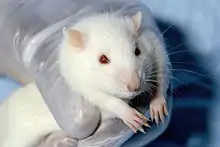Animal testing on invertebrates
Most animal testing involves invertebrates, especially Drosophila melanogaster, a fruit fly, and Caenorhabditis elegans, a nematode. These animals offer scientists many advantages over vertebrates, including their short life cycle, simple anatomy and the ease with which large numbers of individuals may be studied. Invertebrates are often cost-effective,[1] as thousands of flies or nematodes can be housed in a single room.
.jpg.webp)
With the exception of some cephalopods in the European Union, invertebrate species are not protected under most animal research legislation, and therefore the total number of invertebrates used remains unknown.[2]
Main uses
| Animal testing |
|---|
 |
| Main articles |
| Testing on |
| Issues |
| Cases |
| Companies |
| Groups/campaigns |
|
| Writers/activists |
| Categories |
|
Research on invertebrates is the foundation for current understanding of the genetics of animal development. C. elegans is especially valuable as the precise lineage of all the organism's 959 somatic cells is known, giving a complete picture of how this organism goes from a single cell in a fertilized egg, to an adult animal.[3] The genome of this nematode has also been fully sequenced and any one of these genes can easily be inactivated through RNA interference, by feeding the worms antisense RNA.[4] A major success in the work on C. elegans was the discovery that particular cells are programmed to die during development, leading to the discovery that programmed cell death is an active process under genetic control.[5] The simple nervous system of this nematode allows the effects of genetics on the development of nerves to be studied in detail.[6] However, the lack of an adaptive immune system and the simplicity of its organs prevent C. elegans from being used in medical research such as vaccine development.[3]
The fly D. melanogaster is the most widely used animal in genetic studies. This comes from the simplicity of breeding and housing the flies, which allows large numbers to be used in experiments. Molecular biology is relatively simple in these organisms and a huge variety of mutant and genetically modified flies have been developed.[7] Fly genetics has been vital in the study of development, the cell cycle, behavior, and neuroscience. The similarities in the basic biochemistry of all animals allows flies to be used as simple systems to investigate the genetics of conditions such as heart disease and neurodegenerative disease.[8][9] However, like nematodes, D. melanogaster is not widely used in applied medical research, as the fly immune system differs greatly from that found in humans,[10] and diseases in flies can be very different from diseases in humans.[11]
Other uses of invertebrates include studies on social behavior.
See also
References
- Andre, RG, RA Wirtz, and YT Das (1989). "Insect Models for Biomedical Research" Archived October 19, 2008, at the Wayback Machine. In: Nonmammalian Animal Models for Biomedical Research, AD Woodhead (Editor), CRC Press: Boca Raton, FL. Retrieved November 13, 2008.
- Horvath, Kelsey; Angeletti, Dario; Nascetti, Giuseppe; Carere, Claudio (2013). "Invertebrate welfare: an overlooked issue". Annali dell'Istituto Superiore di Sanità. 49 (1): 9–17. doi:10.4415/ANN_13_01_04. ISSN 2384-8553. PMID 23535125.
- Schulenburg H, Kurz CL, Ewbank JJ (2004). "Evolution of the innate immune system: the worm perspective". Immunol. Rev. 198: 36–58. doi:10.1111/j.0105-2896.2004.0125.x. PMID 15199953.
- Lee J, Nam S, Hwang SB, et al. (2004). "Functional genomic approaches using the nematode Caenorhabditis elegans as a model system". J. Biochem. Mol. Biol. 37 (1): 107–13. doi:10.1016/j.cbpc.2004.06.015. PMID 14761308. Archived from the original on 2007-10-22.
- McCarthy JV (2003). "Apoptosis and development". Essays Biochem. 39: 11–24. doi:10.1042/bse0390011. PMID 14585071.
- Seifert M, Schmidt E, Baumeister R (2006). "The genetics of synapse formation and function in Caenorhabditis elegans". Cell Tissue Res. 326 (2): 273–85. doi:10.1007/s00441-006-0277-2. PMID 16896949.
- Dietzl G, Chen D, Schnorrer F, et al. (2007). "A genome-wide transgenic RNAi library for conditional gene inactivation in Drosophila". Nature. 448 (7150): 151–6. Bibcode:2007Natur.448..151D. doi:10.1038/nature05954. PMID 17625558.
- Marsh JL, Thompson LM (2004). "Can flies help humans treat neurodegenerative diseases?". BioEssays. 26 (5): 485–96. doi:10.1002/bies.20029. PMID 15112229.
- Bier E, Bodmer R (2004). "Drosophila, an emerging model for cardiac disease". Gene. 342 (1): 1–11. doi:10.1016/j.gene.2004.07.018. PMID 15527959.
- Leclerc V, Reichhart JM (2004). "The immune response of Drosophila melanogaster". Immunol. Rev. 198: 59–71. doi:10.1111/j.0105-2896.2004.0130.x. PMID 15199954.
- Mylonakis E, Aballay A (2005). "Worms and flies as genetically tractable animal models to study host-pathogen interactions". Infect. Immun. 73 (7): 3833–41. doi:10.1128/IAI.73.7.3833-3841.2005. PMC 1168613. PMID 15972468.
Further reading
General
- Lawrence PA. "The Making of a Fly: The Genetics of Animal Design." Blackwell Publishing Limited (March 1, 1992) ISBN 0-632-03048-8
- Demerec M. "Biology of Drosophila" Macmillan Pub Co. (January 2000) ISBN 0-02-843870-1
- Hall, DH. "C. Elegans Atlas" Cold Spring Harbor Laboratory Press (November 30, 2007) ISBN 0-87969-715-6
Practical
- Goldstein LSB, (Ed) Fryberg EA. "Methods in Cell Biology: Drosophila Melanogaster : Practical Uses in Cell and Molecular Biology" Academic Press (January 1995) ISBN 0-12-564145-1
- Epstein HF, (Ed), Shakes DC. "Methods in Cell Biology: Caenorhabditis Elegans : Modern Biological Analysis of an Organism" Academic Press (October 1995) ISBN 0-12-240545-5